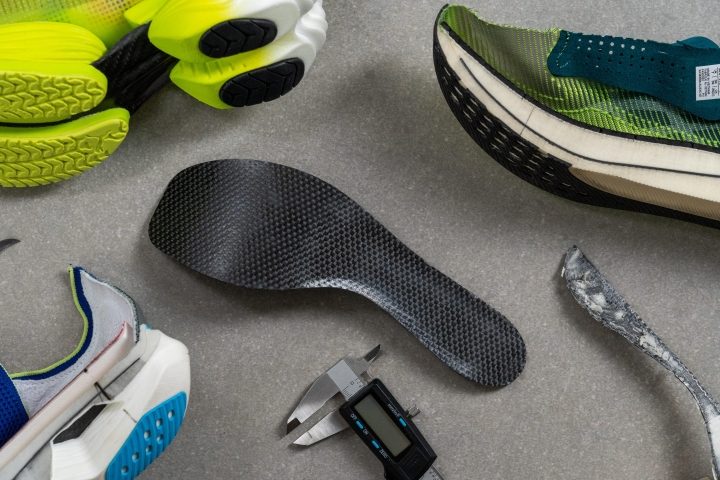
This guide covers what to expect from carbon plated shoes, how much they can improve running times and when they will not work. We’ve spent 20+ hours researching the topic and summarizing scientific conclusions and our lab data.
Here, we don’t take sides in the “what did the carbon-plated shoes do to running” debate.
The majority of carbon-fiber plated shoes are race-ready. Given that these shoes were made and tuned for elite runners, they work best if you’re a competitive runner who is:
- Fit
- Ideally: forefoot/midfoot striking (with exceptions)
- Fast (not a beginner at least)
- Able to afford their premium price.
Examining the carbon plate on a shoe cut in half in our lab
How fast can you be in carbon-fiber plated running shoes
Runners wearing carbon-plated shoes managed to break every woman and man record from 5km to a marathon since the introduction of carbon-plated running shoes in 2016.
The most comprehensive studies have been conducted based on the Vaporflys. Nike’s claim that the shoes allow for the 4% improvement in the running economy was confirmed (here and here). Translated to running performance, this means 2-3% better finish times. Here are a few examples of how those improvements translate to finish times:
| Finish time | 2.5% improved finish time | |
| 5k | 00:34:37 | 00:33:34 |
| 10k | 01:02:08 | 01:00:16 |
| Half marathon | 02:14:59 | 02:10:56 |
| Marathon | 04:26:33 | 04:18:33 |
It’s worth noting that at higher running speeds, the improvement in running economy is higher than the improvement in speed. At slower speeds, the improvement in speed is a bit greater than the running economy improvement (as shown in this study).
Example: at 5.5m/s (world-class marathon pace), it’s predicted that the improvement in velocity is ⅔ of the improvement in the running economy. For someone who’s doing a 2:04 marathon, and has a 3% running economy improvement, this means they will run the marathon 1.97% faster: 2:01:36.
Fun fact: back in 2019, Strava released a report claiming that the fastest runners wore Nike running shoes: Next% and Vaporfly.
Why are these improvements possible? Running in carbon-plated shoes allowed for metabolic savings due to:
- Superior energy storage in the foam
- Clever lever effects of the carbon plate on the ankle joint mechanics
- Stiffening effects of the plate on the metatarsophalangeal joint.
3 reasons carbon-plated shoes won’t work for you
Because they aren’t made for everyone.
1. Recommended runner’s weight for carbon-plated shoes
Heavy or too-skinny runners might not feel the expected benefits. Heavy runners tend to land on the heel and lightweight runners might not have enough weight to properly activate the plates. Professional athletes, whom most of the carbon-plated shoes are aimed at, are usually in the middle: fit.
2. Recommended pace for carbon-fiber plated shoes
Mind your pace.
Activating the plated shoe: fast-paced run + avoiding the heel strike:
These shoes might be unstable at slower paces and, chances are, you won’t feel that special “pop” when just jogging. Pick up your pace.
Unstable heel in Nike Alphafly 3
This study even suggested that Nike Vaporfly could be used for track racing next to road racing.
There are, however, some carbon-plated daily trainers. In that case, you are good even at slower speeds. It’s just a matter of affording an expensive daily trainer (for context, New Balance Lerato costs $230).

Nike Zoom Fly 5, a carbon-plated shoe that we found to work better as a daily trainer for long runs than as a speed/race shoe
3. Recommended foot strike for carbon-plated shoes
The design of carbon-plated shoes either dictates a forefoot-midfoot strike or leaves it “open for all”.
When there are enforcements across the forefoot of the outsole, they suggest the shoes are made for forefoot/midfoot striking runners and they are there to ensure proper grip and durability.

Outsole rubber coverage in carbon-plated running shoes favoring forefoot-midfoot heel strike
However, there are carbon-plated shoes whose outsoles are completely covered with rubber or have reinforcements at the heel area as well. This suggests they were made for heel strikers too. It’s always best to try them on and feel whether they actually propel you forward.

Rubber placement on a carbon-plated running shoe outsole
If you want to learn more about footstrike, read our Ultimate guide on foot strike.
How to choose THE BEST carbon-plated running shoe FOR YOU
Option A: Comfort.
If you already answered the 3 requirements mentioned above, find the most comfortable carbon-plated shoe. We always say comfort is the key.
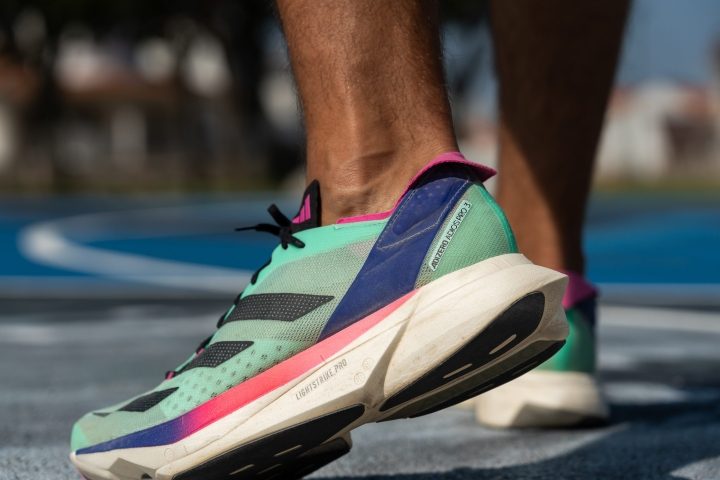
Perfect-fitting Adios Pro 3 during our wear test
Option B: Lab test.
However, if you want to make every second of your run count, hit the lab. Other athletes have been doing it as well (look at the Tweet from Dan Nash, or read how Malindi Elmore used the lab data to choose the better shoe).
What this means is that you should find a physiology lab where you can perform running tests on a treadmill in different shoes and at different paces while a physiologist measures your oxygen consumption (you should be breathing through a mask).
The personal approach proved highly valuable even in the case of Bekele since the original Vaporflys worked much better for Kipchoge than him.
This is the only way you can accurately measure which shoe will make you the fastest possible.
8 things that distinguish carbon-plated shoes from other running shoes
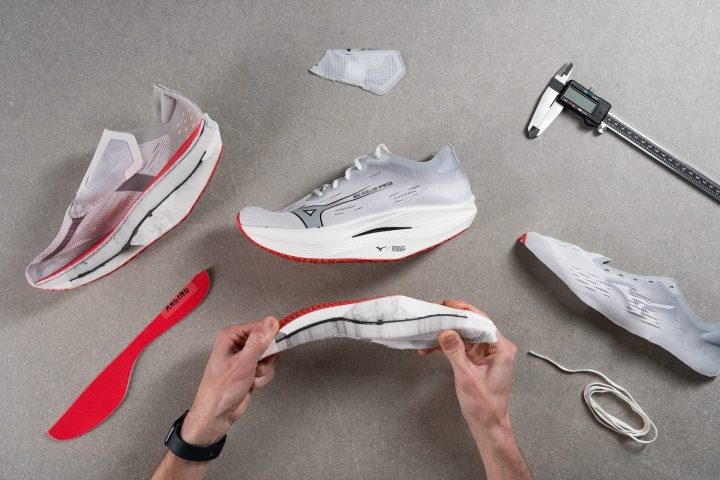
Carbon-plated Rebellion Pro 2 cut in half in RunRepeat lab and ready for further testing
While it’s still not clear where the 4% improvements come from (is it the plate, the straighter toes, less work for the ankles, or the foam resilience…), we test and dissect the shoes and know what makes them different.
This is not a list of what to look for but rather what you should expect and be aware of when you decide to add a carbon-plated running shoe to your shoe rotation:
- Lightweight
- Soft
- Stiff
- Responsive
- High-stacked
- Unstable
- Not durable
- Expensive
We’ll cover all these features separately below.
Carbon-plated shoes are lightweight
The weight of the carbon-plated shoe came as a surprise at first, given their stack height, but quickly became a norm, given all the new technologies that are making the foams superlight.
The average weight of all road running shoes with a carbon-fiber plate we've tested so far in our lab sits at 8 oz or 228g, while the average for non-plated road shoes is 9.5 oz or 270.5g.
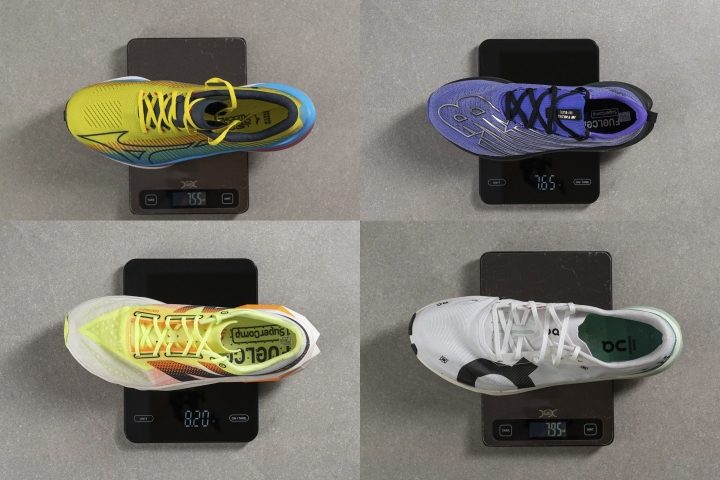
Weighing carbon-plated running shoes in RunRepeat lab
Plated midsoles are soft and stiff
Carbon-fiber plated shoes are softer and stiffer than other non-plated running shoes.
Without carbon-fiber plates, these shoes would just let your feet sink in and would not be responsive at all. Plates stiffen them up and make them pop. The fact that running in stiffer shoes might reduce muscle fatigue on long distances is a cherry on top.
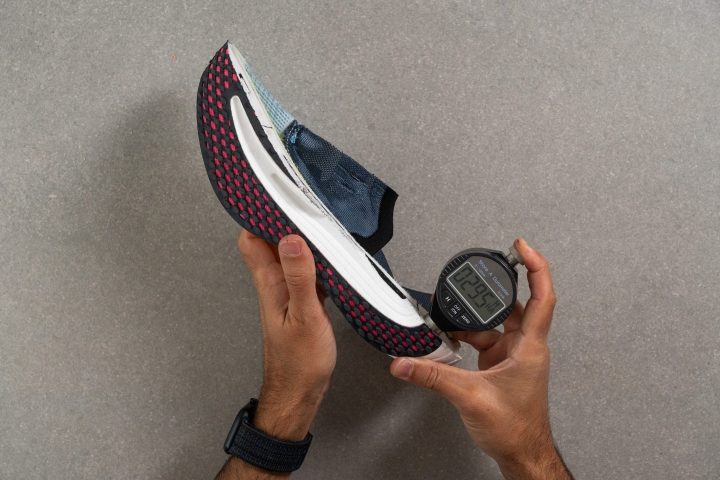
Using a shore A durometer to measure the midsole softness of a carbon-plated running shoe in RunRepeat lab
What makes them different is also being resilient: the foam returns most of the energy you use to squish it.
- Average midsole softness of running shoes with a carbon-fiber plate: 18.9 HA
- Average midsole softness of running shoes without a plate: 21.7 HA
If you’re unsure about the difference between midsole hardness and stiffness, look at our 2 guides: Guide: Soft vs. Firm Running Shoes and Guide: stiff vs. flexible running shoes.
When it comes to stiffness, we do 2 types of tests. To assess torsional rigidity, we twist them and assign a 1-5 rating, where 5 is the most rigid.
When testing the stiffness, we clamp the forefoot to the table and then bend the shoe to 90 degrees using a digital force gauge. The lower the number on the gauge, the more flexible the shoe is!
This means we need less force to bend it, making the shoe more flexible.
| Flexibility of plated and non-plated road running shoes | ||
| Carbon-plated shoes | Non-plated shoes | |
| Avg. torsional rigidity | 4.5 | 3.1 |
| Avg. stiffness | 61.3N | 25.3N |
Stiffer shoes are better for sprint performance (source) and even for long distances, but it’s important not to go too stiff, as shown below.
We’ve covered this in-depth in our guide on stiff running shoes.
Superb springiness
Most common descriptors: Bouncy. Like a trampoline. Pushes you forward. Wants you to run, wants you to run fast. Propels you.
It’s how good these shoes are.
A fast ride offered in ASICS MetaSpeed Sky:
This extraordinary spring comes from a carbon-fiber plate that works in perfect tandem with a highly resilient foam:
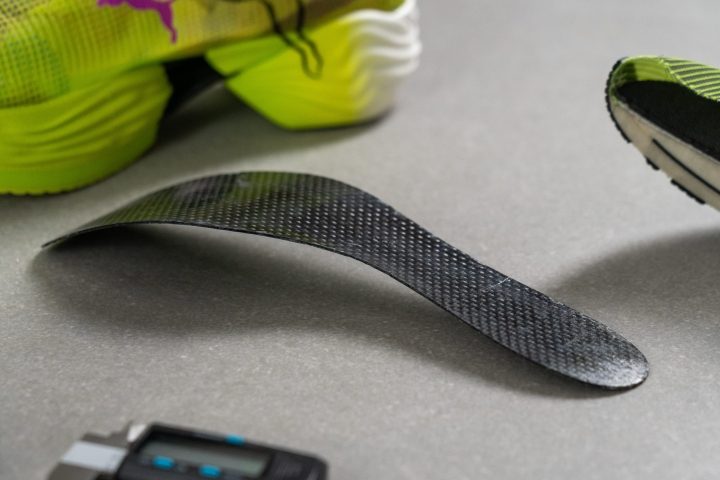
Carbon plate taken out from the midsole
Premium price of carbon-plated running shoes
These come at a steep price:
- Average price of road running shoes with a carbon-fiber plate: $217.2
- Average price of road running shoes with no plate: $129.5
On average, carbon-plated running shoes are 40.4% more expensive than non-plated running shoes.
High off the ground in carbon-plated shoes
So high that World Athletics had to come up with regulation and limit the height of the shoes to 40mm. Anything above and you’re disqualified in road running events. Pushing all the boundaries is, for example, Adidas Adizero Prime X at 50mm in the heel.
Running in New Balance Elite v2 with 34mm in the heel:
For context, look at these numbers on stack heights between shoes with and without a carbon-fiber plate:
| Plated shoes | Non-plated shoes | |
| Avg. forefoot height | 28.4 mm | 23.8 mm |
| Avg. heel height | 36.2 mm | 33.1 mm |
Here’s how we measure heel and forefoot stack height in our lab: at 12% and 75% of the internal length of the shoe on the centerline.
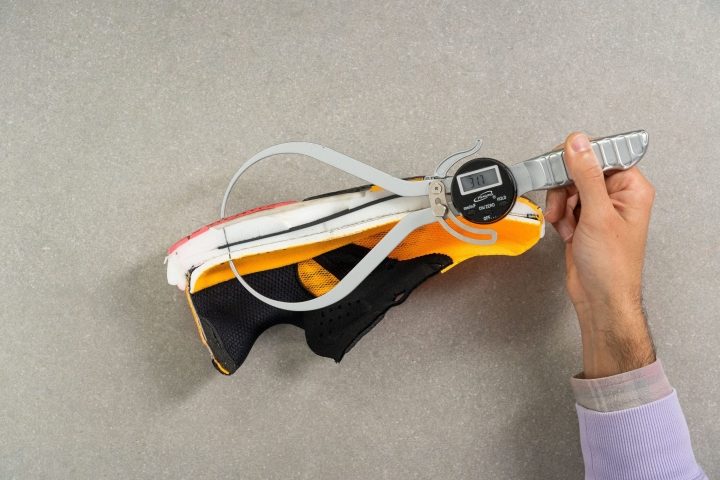
Measuring the heel stack height with a digital caliper in RunRepeat lab

Forefoot stack height measurement using a digital caliper
Unstable for walking, sharp turns and uneven terrain
As mentioned above, due to their high stacks, narrow platforms soft foams, and race profile, carbon-plated shoes are usually really unstable. Especially at the rearfoot area.
Heel instability noticeable on the sharp turn in the Alphafly 3
That’s why they ask for some adaptation period and are not recommended for trails (unless we’re talking about carbon-plated trail shoes). Best for running fast and running straight ahead.
How narrow are these shoes at the base? Let's compare them to the non-plated shoes:
| Carbon-fiber plate | Shoes with no plate | |
| Avg. midsole forefoot width | 111 mm | 114 mm |
| Avg. midsole heel width | 84.9 mm | 91.1 mm |
At the heel, they are 6.2 mm narrower on average!
Here’s how that instability looks like in Nike Vaporfly Next%2 (left) and New Balance Elite v2 (right):
How durable are carbon-plated running shoes?
They started as race shoes. Even though we can find some plated daily trainers, when it comes to plated competition running shoes, they should be saved for race days given their lack of durability. They usually lack thicker rubber at the bottom or have too much of the midsole exposed.
In our lab, we test the durability of running shoes in 3 places: toebox, heel padding, and outsole. We press our Dremel against the material and assess or measure the damage we've made.
Testing the durability of Adidas Adizero Adios Pro 3 using a Dremel in RunRepeat lab
The bigger the damage, the less durable the material. We always apply the same pressure and RPMs, so all these results are comparable between shoes.
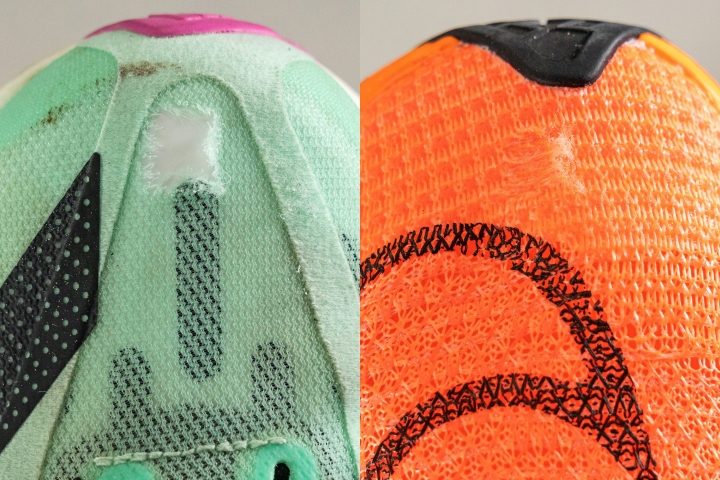
Non-durable (rated 1/5) vs. a durable toebox (rated 5/5) in carbon-plated running shoes
Testing the durability of the heel padding in carbon-plated shoes
The only thing that is different when it comes to testing the outsole's durability is our use of a tire tread gauge. With it, we're able to measure the exact depth of the hole our Dremel has made and to correlate that with the durability. Bigger dent = less durable outsole.
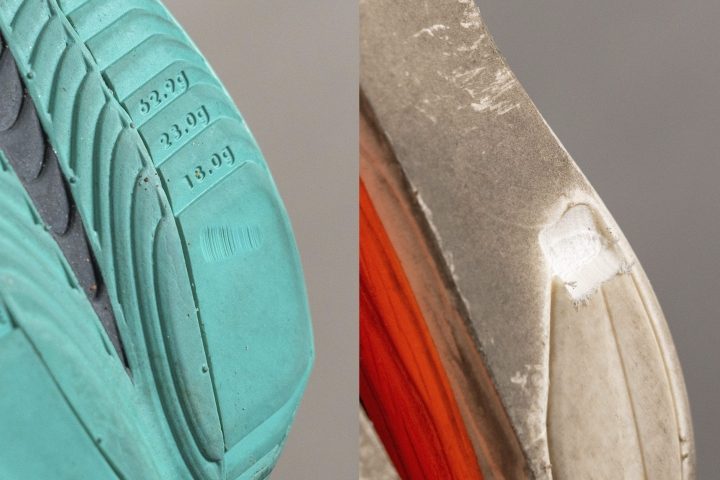
Durable vs. non-durable outsole (at the heel) in carbon-plated running shoes
This number should be taken with a grain of salt because we measure the outsole durability at the heel and, as explained above, carbon-plated running shoes are usually best utilized by forefoot-to-mid strikers.
Length of the carbon plate
Carbon-fiber plates can be full-length or partial. The length of the plate plays a big role in how the shoe performs, together with the foam, and there are different types of foam.
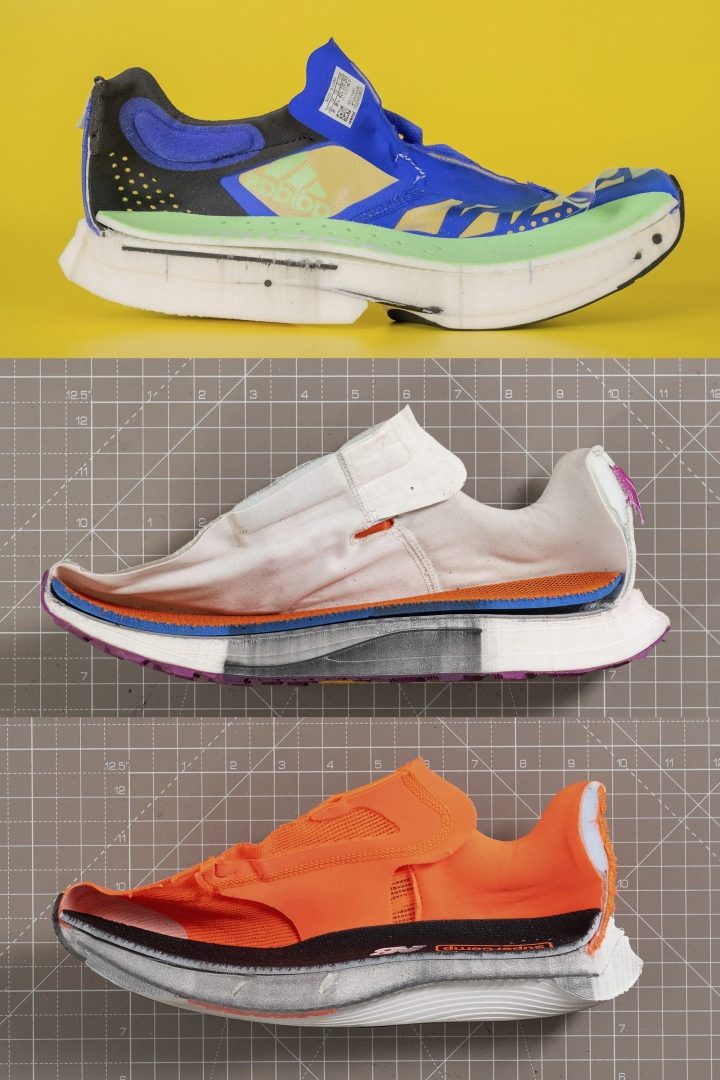
Different lengths of carbon plates visible on shoes cut in half: partial at the heel (up), partial at the midfoot (center), full-length (down)
The longer the plate, the higher the rating for torsional rigidity. Obviously. With shorter plates (for example, just at the heel), this might mean less pop during the ride, as well as less stability. Trail shoes usually have non-full-length plates like the one in the example above (shoe in the middle) as brands tend to use forked carbon-fiber plates in trail running shoes.
For the most comprehensive overview of foams in running shoes, read our insanely detailed guide on foams.
Carbon-plated shoes for trail
First, we had carbon-plated road shoes. Then, carbon-plated trail shoes entered the scene. These shoes offer a snappy ride and are great for the long haul (some, even for 100-mile races).
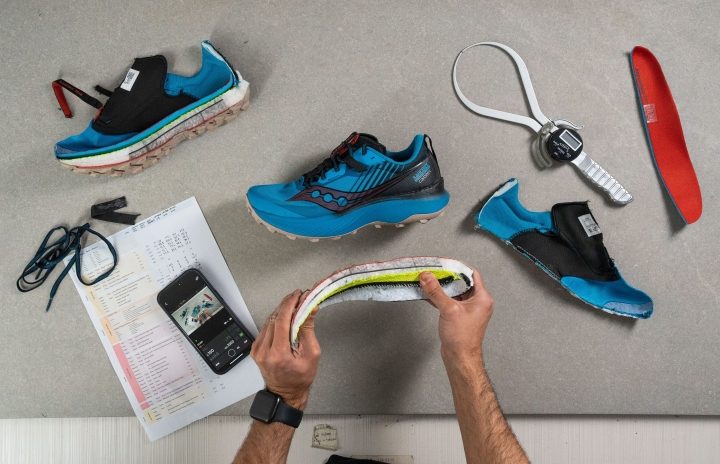
Full-length carbon plate visible in the Saucony Endorphin Edge
The main difference when it comes to our lab testing? Here, we also measure the thickness of the lugs.
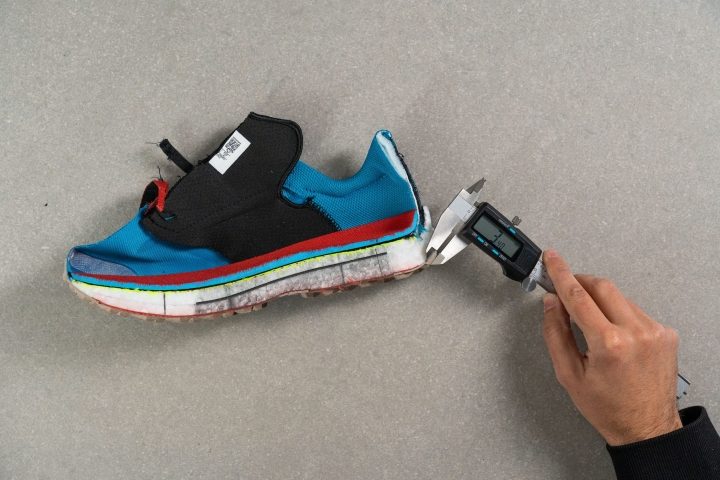
Using a digital caliper to measure the depth of the lugs on a carbon-plated trail shoe
And, when doing the outsole durability test, we damage the lugs.
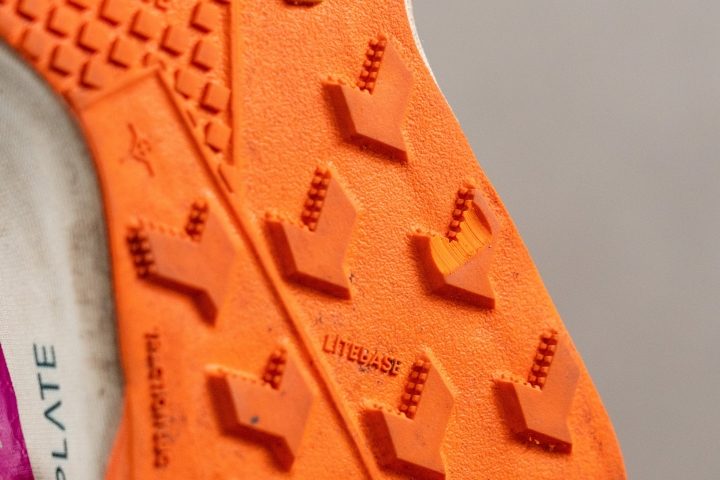
The lug damage made by our Dremel on the outsole-durability test
